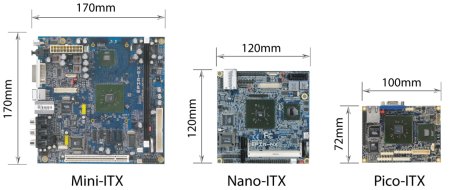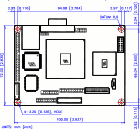Pico-ITX goes “stackable”
Apr 3, 2008 — by LinuxDevices Staff — from the LinuxDevices Archive — 30 views Via's Pico-ITX motherboard form factor may be bound for glory. The form factor has been adopted by the Small Form Factor SIG (special interest group), a group of board and connector vendors planning to add a stackable high-density expansion interface to the tiny motherboard form factor.
Via's Pico-ITX motherboard form factor may be bound for glory. The form factor has been adopted by the Small Form Factor SIG (special interest group), a group of board and connector vendors planning to add a stackable high-density expansion interface to the tiny motherboard form factor.
Currently, Via appears to be the only vendor shipping Pico-ITX boards, having launched its PX10000G and VT6047 reference design last Spring. However, official standards could help pico-ITX gain widespread adoption, much like Via's earlier mini-ITX form factor. Via says it transfered pico-ITX to the SFF-SIG in exchange for standards development and promotional work.
The SFF-SIG said it plans to release initial pico-ITX standards documentation within several months. It hopes its efforts to build standards around pico-ITX will create an “ultra-mobility silicon platform” for the decade ahead, it said.

Via's incredible shrinking motherboard
(Click for details)
 Pico-ITX mechanical drawing (Click to enlarge) |
President Colin McCracken confirmed that the SFF-SIG plans to define a “Stackable Unified Module Interconnect Technology” (SUMIT) interface that should make pico-ITX more modular and expandable, and thus better suited to industrial deployments. Based on a bladed, high-density Samtec connector from SFF-SIG member Samtec, the SUMIT connectors will carry signals that include PCI Express, USB, SPI, I2C, and LPC (low-pin count for serial, PS/2, and so on). Thus, pico-ITX boards will gain expansion options that range from low-speed, low-power serial interfaces to PCI Express connected peripherals like ExpressCards. The SFF-SIG plans to reveal more details about SUMIT at ESC in two weeks, McCracken confirmed.
The addition of a stackable interface to pico-ITX invites comparison with PC/104, the original stackable embedded form factor. Originally equipped with a PC (ISA) bus, PC/104 later evolved into PC/104 Plus, which adds PCI expansion, and PCI-104, which keeps PCI and omits ISA. Compared to PC/104 boards, which measure 3.6 x 2.8 inches, SUMIT-equipped pico-ITX would be smaller — 10.92 vs. 13.68 square inches. And, obviously, they would benefit from high-speed serial expansion in the form of PCI Express, which does not seem to have found its way into PC/104 yet.
Daniel Wu, VP at Via, stated, “We see an opportunity to rapidly build the market for Pico-ITX by working with the SFF-SIG to standardize it.”
SFF-SIG President Colin McCracken stated, “Adopting Pico-ITX is the first step toward creating a unified embedded platform for ultra mobility silicon. Our next order of business is to define the SUMIT expansion interface.”
McCracken added, “OEMs have requested both high-speed and low-speed serial buses for space efficiency, with an emphasis on low power and easy connectivity. We are working with chipset vendors to determine how ultra mobility silicon can best meet these needs over a ten year time horizon.”
SFF-SIG is an open member organization with a tiered dues structure. It describes itself as a non-profit industry group that develops, promotes, and supports small form-factor circuit board specifications and related technologies. Current members include Via, WinSystems, Octagon, Tri-M, and Samtec. Working groups include interface, board, and processor module teams. More details may be available here.
Other recent pico-ITX news includes:
- Delock shipped a pico-ITX based DIN-rail PC
- Via offered a hobbyist-priced Artigo pico-ITX system with chassis
- Sharp and Tappin Technology launched high-style pico-ITX hobbyist systems
- Mini-ITX giant Logic Supply offered a heat-piped pico-ITX case
- Mini-ITX.com reviewed the PX10000G
This article was originally published on LinuxDevices.com and has been donated to the open source community by QuinStreet Inc. Please visit LinuxToday.com for up-to-date news and articles about Linux and open source.